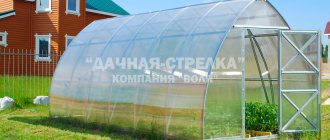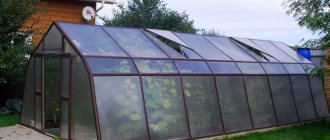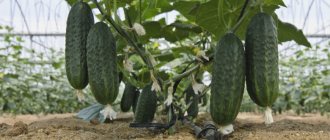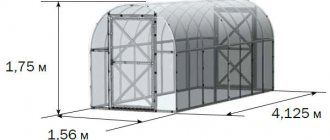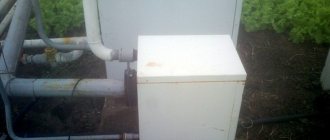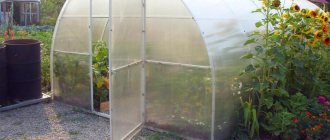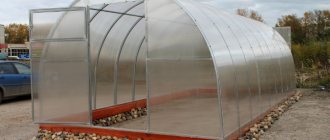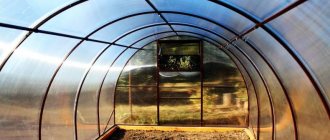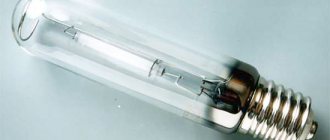Main types
The most popular variety of this series is the “Classic” . There are other buildings, but their differences with the main structure are small - only in length. Each set includes 2 windows and 2 doors. The length of the greenhouse can be from 4 to 8 meters.
The most popular variety of “GreenBox” is the “Classic” greenhouse
The GreenBox mini variety has dimensions of 4.0 x 1.5 x 1.8 meters. The equipment is standard: timber, 2 doors, 2 windows, rolled polycarbonate. Among the features of the structure it is worth highlighting:
- galvanized profile made of steel 1st grade, 1st class, zinc coating - 275 grams per square meter;
- the profile shape is U-shaped, the size of which is 20x30 millimeters, and the thickness is 1.2 millimeters;
- frame elements are connected to each other by special inserts made of galvanized steel;
- The frame is stable and withstands harsh weather conditions.
All GreenBox buildings, which have only positive reviews, are equipped with cellular polycarbonate with UV protection. The material has a high degree of light transmittance and a density of over 0.8 kg per square meter. There is polycarbonate of various colors - you can choose any one.
“Box” greenhouses are designed for 2-3 beds
Galvanized beds
Gardeners and gardeners very often buy equipment such as galvanized beds. They are very convenient for setting up separate flower beds or for fencing one type from another.
Types of galvanized beds:
- Low beds. Often these are the cheapest designs that do not have a polymer coating. In addition, they have no ribs, and their height can vary from 15 to 20 cm. They are excellent for arranging small flower beds.
- Middle beds. They can be either coated or uncoated. Often their height is 20 cm. In addition, they have hard ribs. This is an excellent solution for arranging greenhouses.
- High beds. Their height can be up to 40 cm. They are great for garden or vegetable plots. They have rigid ribs and are also equipped with additional ties and jumpers.
The design of a thermos greenhouse and its construction with your own hands
The Greenbox company produces medium-sized beds. It is beds of this size that are perfect for arranging greenhouses. Therefore, if you don’t want to bother for a long time, you can buy both greenhouses and beds from the same company.
Galvanized beds from the Greenbox company have the following advantages:
- Mobility and ease of movement.
- Not susceptible to corrosion processes.
- Fast and easy installation.
- Versatility in use.
A mid-level galvanized bed can have a height of about 20 cm, parallel lintels, and a polymer coating. The beds from this company are perfect for both greenhouses and ordinary garden plots. If we talk about service life, they can be about 20 years.
Advantages and disadvantages
Reviews about the greenhouse are mostly positive. The structure is inexpensive, but it is reliable. Perhaps this is why many consumers choose GreenBox. Another positive feature worth noting is that the design:
- not afraid of harsh weather conditions;
- plants feel protected in it;
- the frame is able to withstand large accumulations of snow and hail impacts;
- Unlike standard film, polycarbonate can withstand direct sunlight for decades.
Moreover, all of these qualities can be tested in practice by absolutely any gardener. The Box greenhouse is, as reviews say, inexpensive.
Advantages of a greenhouse
It should be emphasized that reviews of such greenhouses are overwhelmingly positive . This is not surprising, since they are particularly reliable and inexpensive. But the list of advantages also includes the following:
- Ergonomic shape. This arched design helps to withstand strong gusts of wind, as well as heavy snow loads.
- A light weight. In total, a greenhouse from Greenbox can weigh up to 80 kg. Therefore, it is very easy to transport. In addition, you should pay attention to the fact that it does not require a separate foundation.
- Fast and easy installation. There is no need to use a welding machine during assembly, so installation does not take much time.
- Practicality and reliability. Such a greenhouse does not need to be dismantled for the winter. Therefore, it can easily become a good storage facility, but that time will not begin until the landing begins.
Polycarbonate greenhouse with opening roof
Polycarbonate greenhouse "GreenBox" (video)
An optimal microclimate for plants is created inside the building. As a result, the yield on the site increases several times. Providing the required level of illumination and comfortable temperature leads to the fact that the ripening of crops occurs much faster. You end up getting more vegetables than you planned.
The “Box” greenhouse looks, as reviews note, neatly. Not only will it not spoil the appearance of the site, but it will also make it even more attractive. Maintenance is simple - it only involves eliminating “holes” if they appear over time.
There are practically no downsides. The only disadvantage that can be noted is the limited length of the building.
Greenhouse heating | Greenbox Blog
Greenhouse owners know that without high-quality and proper heating of the greenhouse, a good harvest cannot be expected. If the greenhouse is well heated, then you can grow vegetables all year round without worrying about the safety of the seedlings. So, there are plenty of heating methods, all that remains is to choose the best option.
- The most common and cheapest method is solar heating. The greenhouse must be located in an open space and also have transparent glazing. However, such heating has a number of disadvantages: in winter you cannot grow seedlings, because the temperature at night drops significantly and during this period of time all the greenery may die. It is advisable to combine this type of heating with others.
- Biological. Microorganisms, decomposing in a greenhouse, release heat sufficient for the growing season. During the decomposition process, a large amount of CO2 is released - the main source of food for young plants, and the soil is well moistened as a result of the activity of microorganisms. Horse manure is used as a “bioheater”.
- Electric heating. All developed countries have switched to this type of heating. European farmers use heat guns, special heating mats and convectors. In addition, in modern greenhouses there are automatic sensors that activate heating when the temperature drops below a certain level (greenbox greenhouses are equipped with such sensors).
- Convection systems. The greenhouse is equipped with heating coils and is heated evenly. Disadvantages include the complex installation of spirals and insufficient heating of the soil.
- Heaters are small portable fans. In sufficient quantity, they can quickly and evenly heat the entire greenhouse. Fans can also work as air conditioners and, if necessary, lower the temperature in the greenhouse. The only disadvantage of the fan is excessive drying of the soil.
- Cable heating. A universal heating method, the cable can be installed outside and prevent cold from entering the greenhouse, or installed inside the greenhouse (it is buried in the ground) to heat the ground. The most important thing is to choose the temperature regime so as not to overheat the root system of the plants, thereby not destroying the future harvest.
- Water heating. This method is versatile, because it can be used to heat both the soil and the air in the greenhouse. Water heating is not designed for self-installation, so you will have to call a specialist.
Specifications
- “Box” greenhouses are designed for 2-3 beds. The presence of upper longitudinal beams ensures not only the strength of the structure, but also the possibility of tying plants to them.
- The length of the structure can reach from 4 to 8 meters. Height - from 1.8 to 2.1 m. Width is 2.4-3.0 meters. The weight of the structure is about 65 kg.
Installation of GreenBox is simple. The structure can withstand significant weight, and there is no need to lay a heavy foundation
- The frame is U-shaped, steel, galvanized. It is based on a 1.5 mm profile with dimensions of 20 x 30 mm. The temperature range is from -40 to +80 degrees. Reviews say that the structure can withstand a snow load of up to 280 kg per square meter.
- When assembled, the structure is delivered in flat blocks , which means that it can be transported in a passenger car. The windows and doors in the building are located at opposite ends.
- Since the polycarbonate is fastened using steel tape, the material is not pressed through. The appearance of kinks at the fastening site during strong winds is also excluded. The fittings for the greenhouse are also galvanized. Service life – from 10 years and above.
An optimal microclimate increases the yield in the greenhouse several times
Types of Green box greenhouses
The manufacturer of these greenhouses has designed their line to please the most demanding customers.
Thus, the lineup consists of three main models:
- Mini.
- Classic.
- Titan.
They differ in size and functionality. While it is recommended to take the mini for producing seedlings, the other models allow you to grow quite good volumes of vegetables. But most often, greenhouses in our country are used to the maximum, so it is not surprising that any of these models have been tested not only with seedlings, but also with vegetables. But let's look at each type of quiet greenhouse in detail.
Mini: It's all in the size
This is a greenhouse for beginning gardeners or those who are short on land resources. It has quite compact dimensions: width 140 cm, height 180 cm and length 210 cm.
- You can make two small side beds in it to grow both seedlings and oversized vegetables. It will be useful for lovers of exotic flowers who need more warmth than our latitudes can provide.
- The frame consists of a U-shaped galvanized profile 2 by 3 cm, with a wall thickness of 0.12 cm. At the joints, the frame is additionally fixed with steel inserts to ensure the required structural rigidity. This design will withstand the weather conditions of the central zone of our country with dignity, but is not suitable for northern latitudes.
- The range of temperatures acceptable for a greenhouse ranges from -40 to +80 degrees. In winter, the greenhouse does not require special care.
- Can withstand heavy snow loads.
- The doorway and window are located at opposite ends of the greenhouse. All this is covered with durable polycarbonate fabric that meets the requirements of GOST. It is secured with steel tape and self-tapping screws, which increase resistance to wind and fracture during installation and operation.
Classic: gold standard
This type of greenhouse is in greatest demand, because its size and price are affordable for the majority of the population and are ideal for growing vegetables.
- Unlike the mini model, the width of this one is increased by 1 and 1.6 meters, respectively 240 cm and 300 cm. The height can be the same as the previous model or be 30 cm higher.
- The length of the greenhouse starts from 4 meters and can reach 8.
- The frame arcs have an installation step equal to a meter. This ensures greater strength of the greenhouse.
- The profile parameters are similar to the previous type of greenhouse, but there are twice as many doors and windows.
- The doors are located at the ends of the greenhouse, and the vents are on the sides, parallel to each other. This allows for free access of fresh air, which not only nourishes the plants, but also helps regulate the temperature in the room. Here you can safely place three small beds or two large ones.
Titan: reinforced classic
In terms of external parameters, such as height, width and length, this greenhouse model does not differ from the classic one. But it was created for more severe weather conditions.
- Its entire body is reinforced. Thus, the pitch of the frame arcs is 65 cm, which increased the snow and wind load by almost one and a half times.
- The length of the greenhouse comes in 3 sizes: 4, 6 or 8 meters.
- If desired, the number of windows and doors can be increased from the standard two. It also has a U-shaped profile that is thicker: equal to 0.15 cm.
- Despite the massive structure, it is easy to transport by car to its destination.
- The number of beds is similar to the classic greenhouse model.
Installation Rules
Consumer reviews indicate that the installation of the building is simple. The structure can withstand significant weight, and there is no need to lay a heavy foundation.
Any type of structure presented can be assembled with your own hands. The kit comes with detailed instructions in which everything is clearly described. Each frame element is marked. If you are not confident in your abilities, you can turn to professionals for help. They will quickly and efficiently assemble the structure on your site.
Rules for installing greenhouses
Customer reviews indicate that installation is very simple and does not take much time. In addition, the design of such greenhouses can withstand even the heaviest weight, although there is no need to build a foundation.
You should pay attention to the fact that you can assemble such a greenhouse yourself, since the manufacturer provides detailed installation recommendations.
So, the installation of a greenhouse consists of the following stages:
- Laying and fixing wooden beams.
- The lower base is made of steel.
- Assembly of doors and windows.
- Step-by-step fastening of individual sections using ties.
- Formation of the second end of the greenhouse.
- Installation of the upper beams.
- Final fixation of all connections.
- Laying the seal.
- Laying polycarbonate using steel strips and galvanized self-tapping screws.
It should be noted that after the greenhouse has been almost completely assembled, doors and windows should be installed. In a finished greenhouse you can create 2 to 3 beds.
DIY polycarbonate greenhouse (video)
By choosing the specified greenhouse, you don’t have to worry about the harvest. Reviews about the building are only positive. The reliable frame and polycarbonate cladding serve faithfully for several decades.
In order not to lose the material, be sure to save it to your social network VKontakte, Odnoklassniki, Facebook by simply clicking on the button below:
Gardeners and gardeners who actively follow new products have been familiar with Greenbox greenhouses for several years now. During this time, this greenhouse structure has acquired its ardent fans and those who are skeptical about it, pointing out its main drawback - its size. But that was only the beginning. In a short period of time, the Greenbox company has released a full line of various greenhouses from “mini” to “titanium”. Let's figure out whether it's worth spending money on purchasing such a much-advertised greenhouse?
Cost of a greenhouse with polycarbonate:
| Greenhouse Greenhouse - 4.00 m. | |
| with polycarbonate Yug-Oil-Plast | RUB 21,900 - PROMOTION! (RUB 26,900) |
| with Sellex polycarbonate | RUB 23,500 - PROMOTION! (RUB 28,500) |
| with polycarbonate NANO-Greenhouse (premium, +48% to the yield) | RUB 25,500 - PROMOTION! (RUB 30,500) |
| with polycarbonate – Woggel (Germany) | RUB 27,500 - PROMOTION! (RUB 32,500) |
| Greenhouse "Greenhouse" - 6.00 m. | |
| with polycarbonate Yug-Oil-Plast | RUB 26,900 - PROMOTION! (RUB 31,900) |
| with Sellex polycarbonate | RUB 28,900 - PROMOTION! (RUB 33,900) |
| with polycarbonate NANO-Greenhouse (premium, +48% to the yield) | RUB 30,900 - PROMOTION! (RUB 35,900) |
| with polycarbonate – Woggel (Germany) | RUB 32,900 - PROMOTION! (RUB 37,900) |
| Greenhouse Greenhouse - 8.00 m. | |
| with polycarbonate Yug-Oil-Plast | RUB 31,900 - PROMOTION! (RUB 36,900) |
| with Sellex polycarbonate | RUB 34,500 - PROMOTION! (RUB 39,900) |
| with polycarbonate NANO-Greenhouse (premium, +48% to the yield) | RUB 37,900 - PROMOTION! (RUB 42,900) |
| with polycarbonate – Woggel (Germany) | RUB 39,900 - PROMOTION! (RUB 44,900) |
Design: what are the features
Greenbox greenhouse is a frame made of galvanized profile, covered with polycarbonate. You need to start with the fact that the frame is made from a durable galvanized profile, which is slightly inferior in strength to a steel frame, but at the same time it is lighter, is not afraid of corrosion, and its service life is at least 20 years. The polycarbonate with which the frame is covered is no less durable. This material has proven its reliability and strength long ago, so it is not surprising that it was used as the basis for greenhouses.
In appearance it is indistinguishable from silicate or acrylic glass, but does not have their disadvantages:
- resistant to external damage;
- with a serious impact, the structure may crack, but not break into pieces;
- easily withstands temperature fluctuations;
- optical permeability is the same as glass.
This is all what is best suited for a greenhouse. After all, it is accidental impacts when working in and around the greenhouse that lead to damage to the structure. This means that it cannot accumulate heat, which is necessary for plant growth and further good harvest.
Design Features
Greenhouse “Green” is a structure that includes a frame covered with polycarbonate. Since the frame is based on a galvanized profile, the product is not subject to corrosion. The service life of the building is up to 20 years.
The galvanized profile is very durable - it outperforms even a steel pipe in terms of its characteristics. Galvanized tape is used as fastening. The set includes 7 longitudinal arches. The thickness of the polycarbonate is 4 millimeters.
Summarizing: advantages and disadvantages
The undoubted advantages of these greenhouses include:
- a wide range of temperatures to which the greenhouse is indifferent;
- creating the microclimate necessary for plants;
- hail resistant;
- large snow and wind load;
- possibility of self-assembly;
- long service life;
- three-year warranty from the manufacturer.
Despite all this, it also has a drawback - the lack of holes for self-tapping screws. To secure the polycarbonate to the frame, you need to make holes for the screws yourself and only then connect the structure. Because of this, damage often occurs in these places, which violates the integrity of the greenhouse and creates a place for useful heat to escape.
Judging by the reviews of those who have already owned greenhouses from this company, the disadvantages include the maximum length of the greenhouse.
Reviews
Nikolay, Kaluga, 42 years old.
Greenhouse advertising promised an incredible greenhouse for relatively little money. I started looking for information from other sources, but at that time it was nowhere to be found. I decided to take a chance and bought myself a classic model. I was upset. The self-tapping screws that came with the kit were clearly Chinese and would bend at the slightest impact on them. But they still needed to connect the skin to the frame. And not a single hole. Okay, drilling, as I thought, is not a problem. In total there are three points with cracks at the drilling site and one large hole. Dissatisfied with the greenhouse.
Irina, Moscow region, 38 years old.
Polycarbonate is the cheapest, and this damage is already at the assembly stage. I'm happy with the price, but I'd rather pay extra and buy something better.
Olga, Pskov, 28 years old.
Normal greenhouse. I took two minis and am very pleased. For the third year now I have had excellent seedlings. The coating is excellent, assembled by representatives of the manufacturer. It cost a little more, but no problem. Two neighbors have already bought the same ones, no complaints. It's a pity there isn't enough space, I would have installed more.
